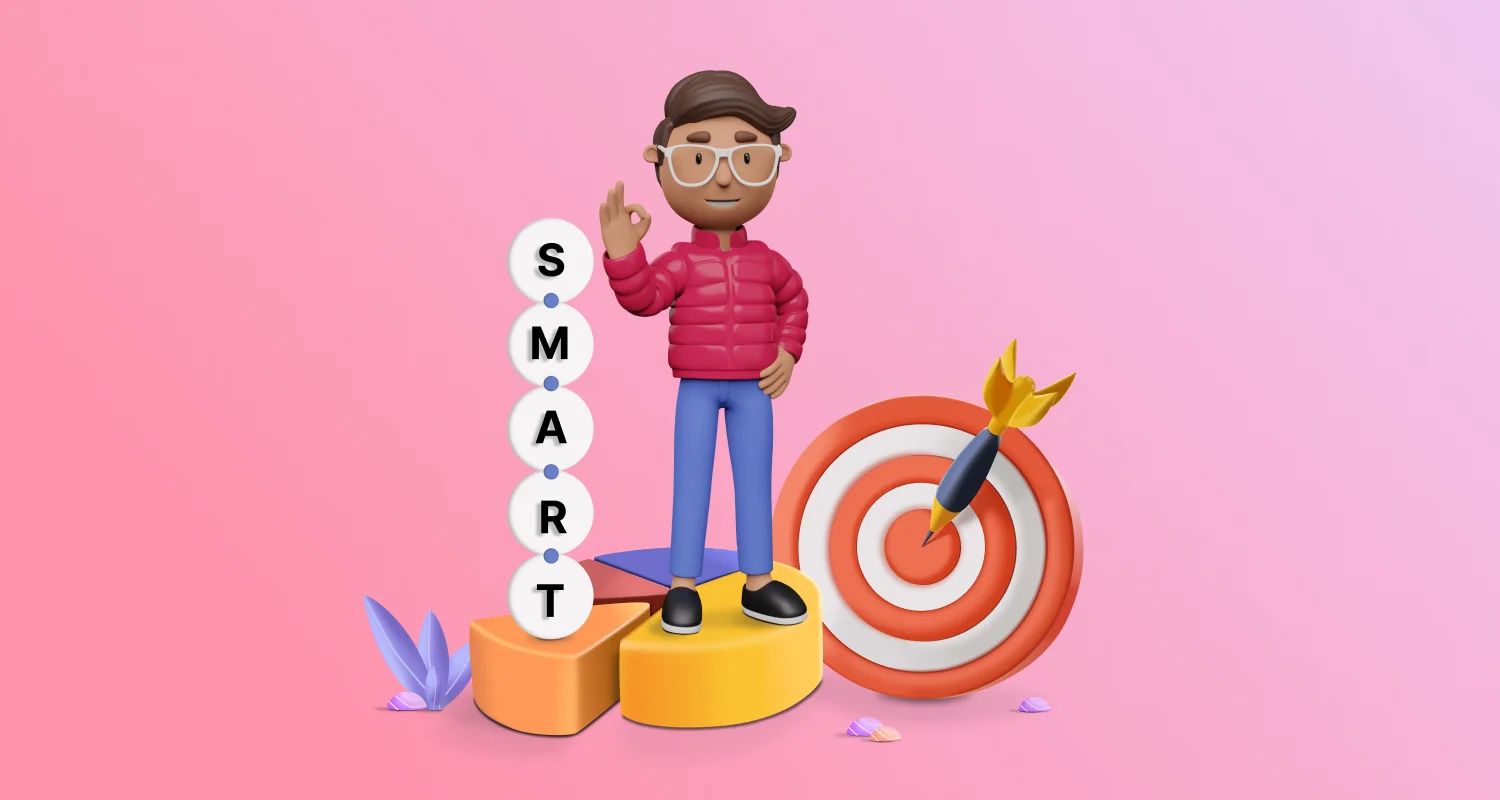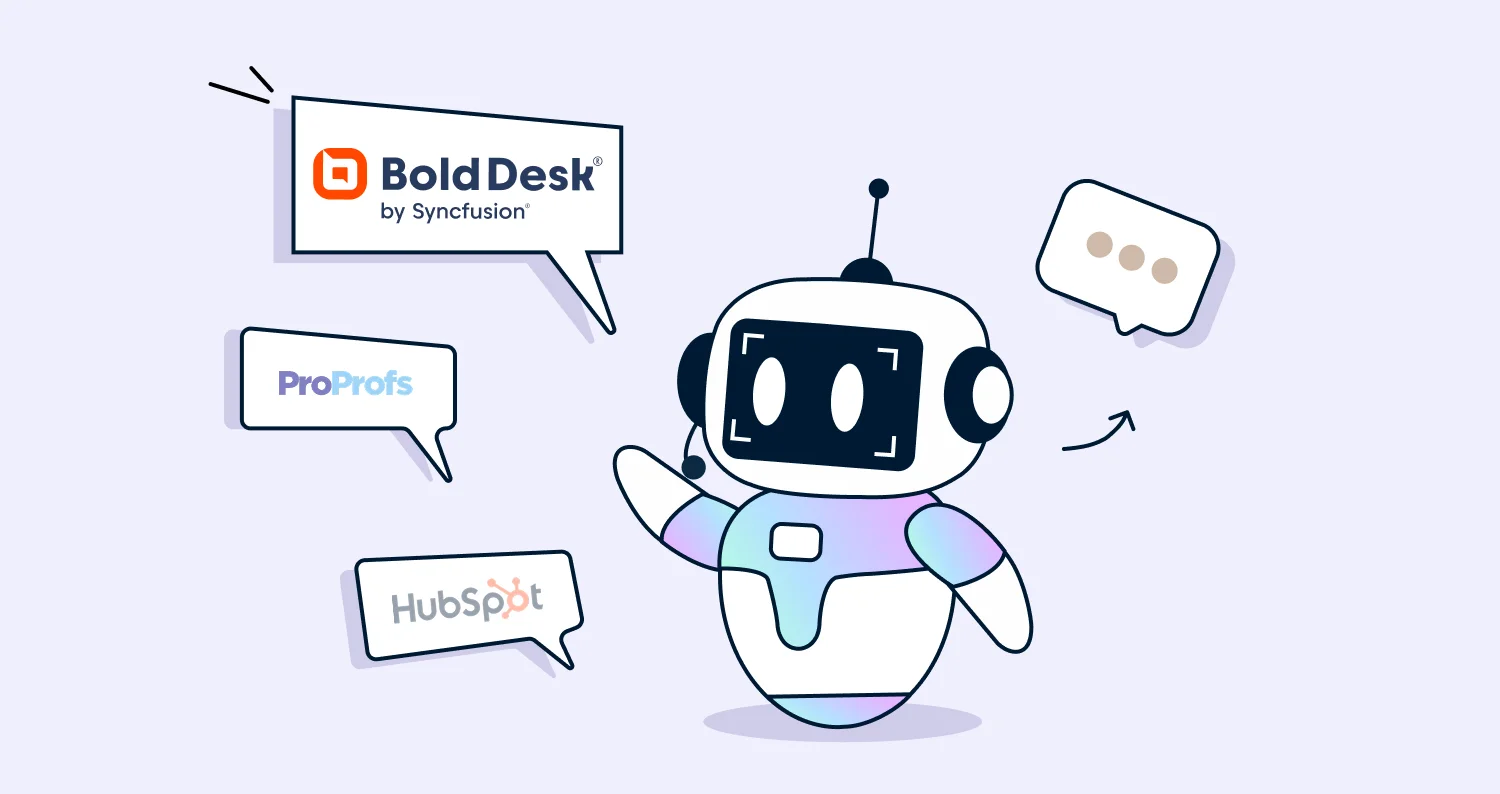How can your support team meet rising customer expectations without a clear roadmap? As customer needs evolve and technology advances rapidly, businesses must continuously adapt their customer service strategies.
But without clearly defined customer service goals, support teams often face misaligned priorities and inconsistent performance.
Well-structured goals, especially those built on the SMART framework, help teams stay focused, improve customer satisfaction (CSAT), and meet growing service standards.
In this blog, we’ll explore what customer service goals are, why they matter, and how to set SMART goals that drive measurable results.
What are customer service goals?
Customer service goals are the objectives your company aims to achieve through its customer service.
These goals can be used to measure the support team’s performance and effectiveness.
A company that establishes customer service objectives and strategies can foster better relationships with its customers.
When setting client service goals, it’s important to make them SMART: specific, measurable, achievable, relevant, and time-bound. This ensures that your goals are clear, trackable, and realistic.
Why are customer service goals important for your company?
In both personal life and commercial ventures, having goals maintains the trajectory to success.
This is particularly vital in customer service, a sector where delivering positive customer experiences and managing numerous communication channels consistently is expected.
Establishing customer service goals can greatly benefit your business and customers in the following ways:
- Improves service quality and provides clear directions: Customer service goals define performance standards and clarify expectations. They ensure that all team members are aligned, focused, and consistently delivering high-quality support. With clear goals, teams can prioritize tasks, make informed decisions, and stay on track.
- Boosts profitability through loyalty: Meeting service goals enhances customer experiences, which in turn foster repeat business, generate positive word-of-mouth, and build lasting loyalty, ultimately driving long-term profitability.
- Enhances accountability and supports performance evaluation: Well-defined goals create a sense of ownership and responsibility. They also provide measurable benchmarks for evaluating individual and team performance, making it easier to recognize top contributors and identify areas needing support or training.
- Motivates employees and engages employees: Having defined customer service goals gives employees a sense of purpose and direction. When achievements are recognized whether through feedback, rewards, or career growth, it boosts morale, engagement, and overall job satisfaction.
How to set SMART goals for customer service in 2025
Clear customer service goals create confident teams. In customer service, success starts with direction.
Setting structured customer satisfaction goals helps support teams stay focused, aligned, and proactive in delivering consistent service.
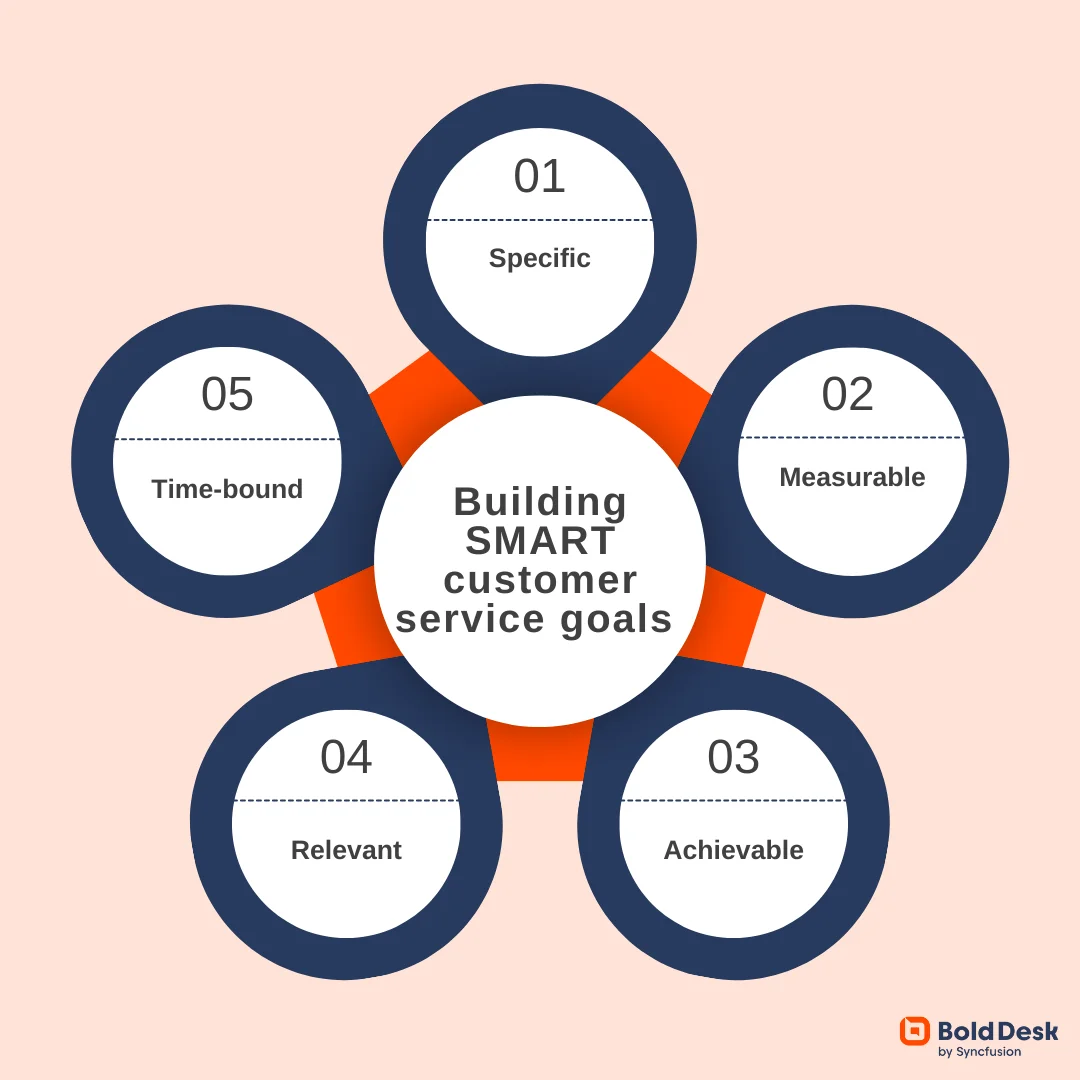
S – Specific
Do your customer service goals clearly show what success looks like? Clear, detailed goals help everyone understand exactly what they’re working towards.
When your team knows exactly what they are aiming to achieve, it reduces confusion, keeps efforts focused, and helps everyone move in the same direction.
M – Measurable
Can you tell exactly when you’ve reached your customer service goals? To stay on track, it’s important to define clear customer service KPIs, such as response time, resolution rate, or customer satisfaction scores.
With the right metrics in place, it’s easier to monitor progress, stay focused, and recognize when success has been achieved.
A – Achievable
Are your goals realistic enough to be reached, yet bold enough to inspire growth? Customer service targets should be challenging but attainable.
High-reaching goals can motivate employees and promote development, but if expectations are too far-fetched, they may lower morale. The key is to encourage teams to stretch beyond their comfort zones while still keeping success within reach over time.
R – Relevant
Does this goal move us closer to our mission? Client service goals should align with your company’s core values and strategic direction.
When goals are relevant, employees understand their purpose, stay motivated, and contribute meaningfully to long-term success.
T – Time-bound
To achieve success in customer service goals, it’s essential to set realistic deadlines that create urgency, motivate teams, and guide progress.
Breaking down ambitious goals into manageable steps helps reduce stress, maintain focus, and ensure consistent achievement within the set timeframe.
11 Best customer service goals to consider (with examples)
Setting SMART goals helps customer service teams stay focused, aligned, and responsive to evolving customer needs.
Below are structured customer service goals examples that illustrate how clear, measurable goals can drive service excellence.
Reduce customer wait time
Good customer service depends on speed. Aim to reduce your first response times (FRT) as a significant goal. A quick response makes customers feel acknowledged and calmer.
According to a research by Salesforce, when customers contact a company, 83% of them anticipate immediate interaction with a representative.
Customers expect fast responses and delays can lead to frustration or even churn. Reducing wait time requires a team-wide effort supported by the right tools, staffing, and streamlined workflows.
Increase customer loyalty
Retaining existing customers is more cost-effective than acquiring new ones. Loyal customers drive repeat business, leave positive reviews, and refer others, boosting profitability.
While there are many strategies to foster loyalty, bad customer service is the fastest way to lose it. The customer service team plays a vital role in reducing churn and strengthening relationships.
By delivering excellent support, resolving issues quickly, and recognizing loyal customers, your team can turn satisfaction into long-term loyalty and long-term loyalty into growth.
Encourage self-service
Businesses aim to use self-service portal to minimize the number of customer queries that require an agent’s intervention. This not only allows customers to resolve simple issues on their own but also frees up your team to focus on more complex, high-value tasks.
Customers increasingly prefer quick, independent solutions over contacting support teams.
A study by Higher Logic found that 79% of respondents expect organizations to offer self-service tools that empower them to find answers on their own.
You can provide self-service resources such as:
- Knowledge bases
- FAQ pages
- Video tutorials
- User forums
Increase customer satisfaction (CSAT)
Happy customers stick around and tell others. That’s why improving customer satisfaction is a top priority for support teams.
To achieve customer satisfaction goals, focus on:
- Truly understanding customer needs
- Delivering high-quality service
- Listening to feedback and acting on it
One of the best ways to measure success is through the customer satisfaction score, a quick survey sent after a support interaction. A high CSAT means your customers feel heard, helped, and happy.
For example, you can use BoldDesk to automatically send CSAT surveys after support interactions and gather actionable feedback.
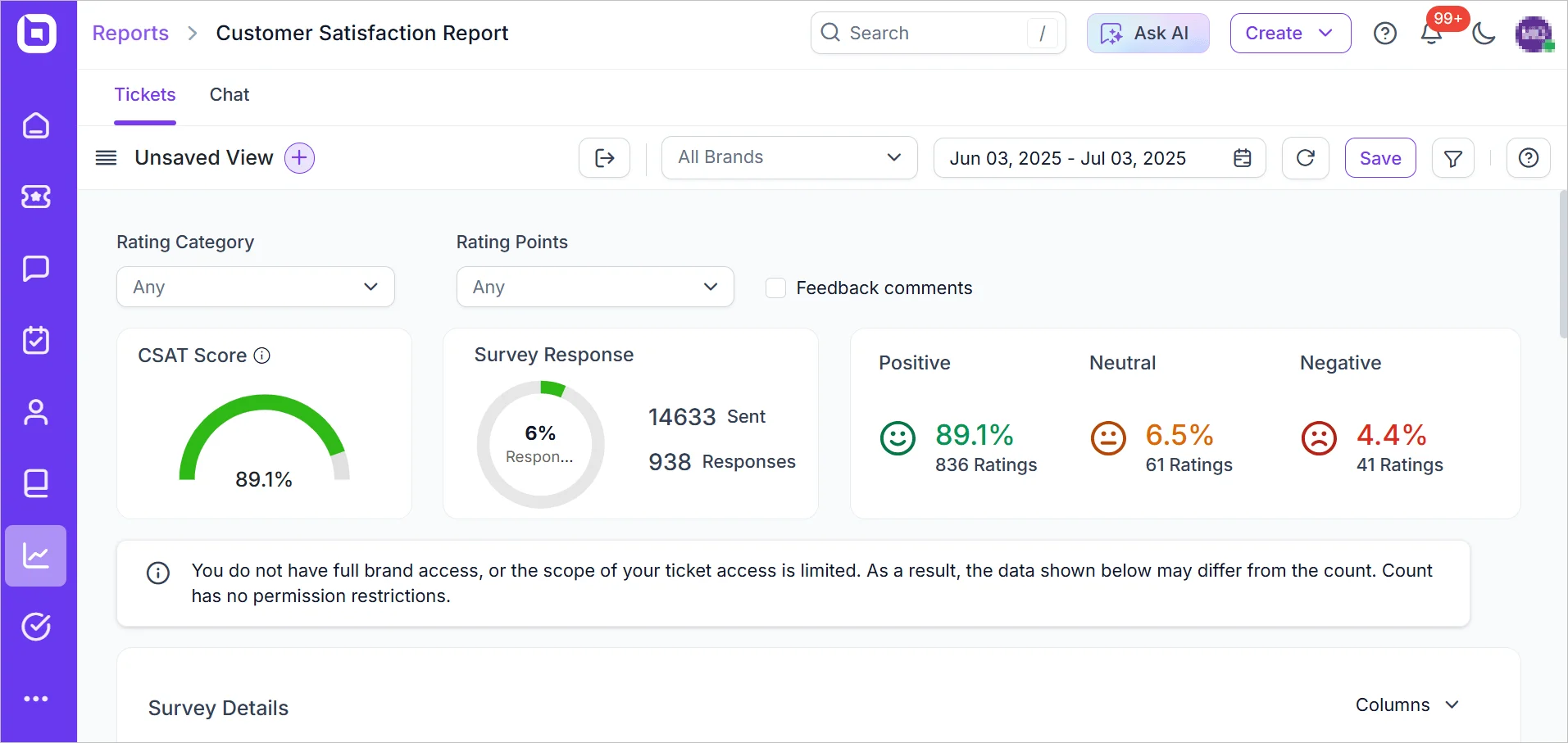
Collect valuable feedback
When customers reach out, it’s often because they’re facing issues and their frustration makes their insights especially valuable. Their feedback reveals how well your service strategies are working to resolve problems and ease irritation.
By actively addressing both positive and negative customer feedback, you show customers that their voices matter and that you’re committed to improvement.
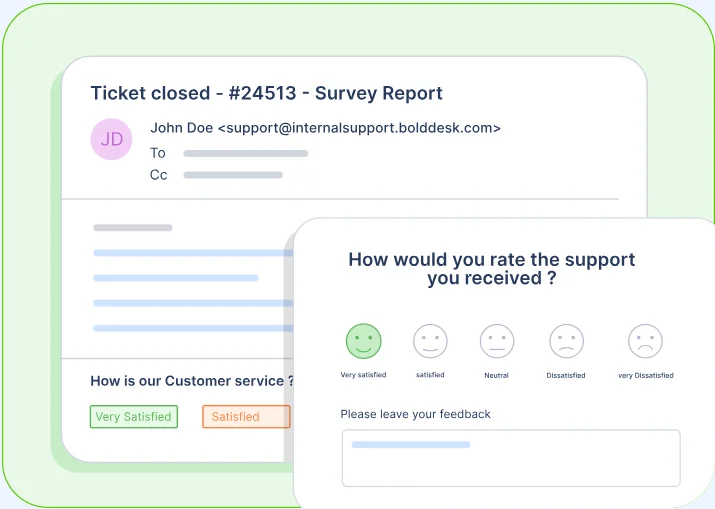
Owning mistakes, resolving issues, and offering goodwill gestures can leave a lasting positive impression, encouraging continued loyalty and business.
Improve employee skills and satisfaction
The quality of your customer service is a direct reflection of your customer service team’s capabilities and satisfaction. Empower your agents with the right tools and ongoing training to boost their confidence, reduce stress, and improve performance.
To keep track of employee satisfaction, managers can distribute anonymous satisfaction surveys regularly. The findings will provide insight into what brings joy to your team, their challenges, and their expectations from the company.
Strengthen your customer onboarding
First impressions matter, especially during customer onboarding. Focus on creating a journey that’s intuitive and supportive from the start.
If users struggle to understand your service early on, their trust can quickly erode and they may never return. We’ve all experienced signing up for a new app or service only to feel lost and frustrated. Your customers shouldn’t have to.
A well-designed onboarding process should guide users effortlessly, helping them achieve value without needing to search for answers or reach out for help.
Leverage social media with creativity
Social media offers a dynamic platform for customer service that goes beyond just responding to complaints.
Supporting users on platforms such as WhatsApp or Instagram, is a highly effective strategy, especially since nearly 48% of customers seek information there before making purchase decisions, according to a 2020 CCMC report.
Creatively integrating social media into customer service involves using innovative and engaging strategies to connect with customers, resolve their concerns, and enhance their overall experience with your brand.
Enhance productivity
Productive teams deliver better service and faster. That’s why boosting agent productivity is a top priority for support leaders.
To achieve this, focus on:
- Empowering agents with the best productivity tools.
- Streamlining workflows and reducing repetitive tasks.
- Minimizing errors and delays through efficient processes and standard operating procedures (SOPs).
One of the best ways to measure success is by tracking agent performance and resolution speed. Faster, error-free support means happier customers and more confident agents.
Improve quality of customer service
To elevate the quality of customer service responses, representatives should ensure that each interaction with a client is not only efficient but also personalized and empathetic.
Enabling them to do so means investing in comprehensive training programs that focus on active listening skills, product knowledge, and compassionate techniques. This empowerment enables support representatives to understand and address customer inquiries accurately and with a genuine sense of care.
Additionally, it involves implementing quality assurance measures such as regular reviews of customer interactions and performance analytics to identify areas for improvement.
Enhance troubleshooting skills
Quick, accurate troubleshooting builds customer trust. That’s why strengthening problem-solving skills is a key customer service goal for support teams.
Start by focusing on:
- Equipping agents with deep product knowledge and familiarity with common customer issues.
- Helping them identify root causes quickly and respond with confidence.
- Reinforcing skills through regular workshops and scenario-based simulations.
Want more loyal customers? Start with SMART goals for support
Setting and achieving SMART customer service goals is key to improving support performance, boosting customer satisfaction, and retaining top talent.
When customer service goals are realistic, measurable, and aligned with team capabilities, they become powerful tools for driving business success and enhancing agent performance.
Ready to elevate your support strategy? BoldDesk equips your team with automation, intelligent ticket routing, and real-time reporting dashboards, making it easier to track KPIs, optimize workflows, and exceed customer expectations.
If you have any questions or feedback, feel free to reach out to our support team for assistance. We’d love to hear your thoughts, share your suggestions, experiences, or ideas in the comments below.
Related articles
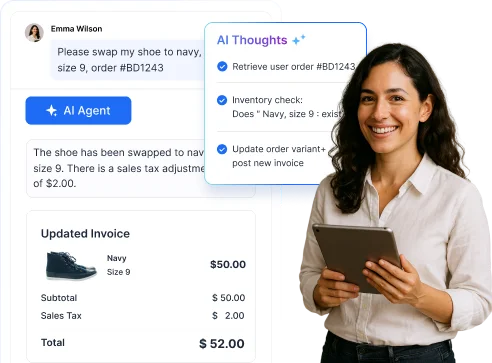


















 Email Ticketing System
Email Ticketing System Shared Inbox Software
Shared Inbox Software Multi Brand Help Desk
Multi Brand Help Desk Internal Help Desk Software
Internal Help Desk Software Trouble Ticketing Software
Trouble Ticketing Software Mobile Help Desk
Mobile Help Desk 









